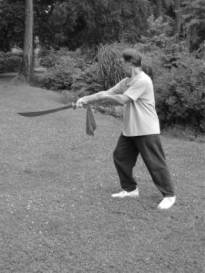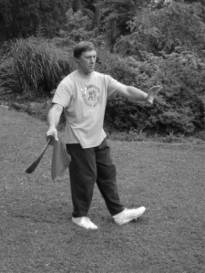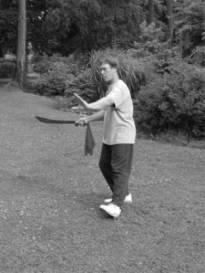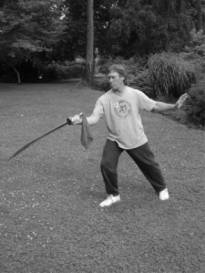 Gilman Studio On-Line Lessons
Gilman Studio On-Line Lessons
Yang Style
Tai Chi Dao/Saber/Broadsword
This Lesson Contains:
Movement #9 Circle To The Right And Uppercut
This movement contains two parts. First, I deal with a poke to my center by cutting the opponents wrist. The second part is a different opponent. She attempts a cut to my waist and I step in, grab her saber hand, and deliver an upper cut to her lower body. I have broken this application into two parts, yet the movement flows as one. Do not break the momentum after the first cut.

 1) Following the previous movement, Stephie threatens from the right side.
1) Following the previous movement, Stephie threatens from the right side.
2) I turn to face her.

 1) She attempts to poke me in my center. I cut her wrist.
1) She attempts to poke me in my center. I cut her wrist.
2) Another person threatens from the left.
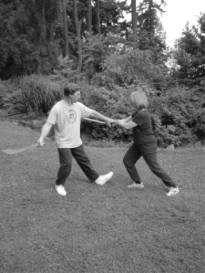
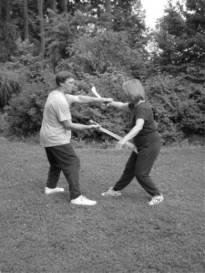 1) Stephie attempts a horizontal cut to my waist. I step in a grab her hand.
1) Stephie attempts a horizontal cut to my waist. I step in a grab her hand.
2) I deliver an uppercut to her lower body.
These two pictures are not quite the same moment. The second one (taken from the left) is actually the first thing to happen in this movement. I sink my weight into the left foot, empty the right foot, and turn the torso to the right.
The right hand stays in the same relative position. The left hand moves up to face the right forearm. The saber is parallel to the ground. At this point I am ready.
The first picture shows the wrist cut starting. Put down the right foot. The toe faces half way between north and west. Start to shift the weight onto the right foot.
Focus on the energy in the center and glance to the right.
Shift the weight onto the right foot. The toe and torso face halfway between north and west.
The saber cuts outward and downward. This is done mostly by the elbow extending. The saber is in line with the right leg and is angled downward slightly. The left hand helps to focus the energy into the saber. Glance at the saber point.
Focus on the cutting edge.
Lift up the left foot and replace it so that the toe faces slightly to the left of west. Keep the weight sinking into the right leg. The torso is starting to turn to the left.
The right hand stays in the same basic position but relaxes. The left hand crosses to the left at the center of the chest level with the palm facing outward.
Focus on the left hand intercepting the opponents saber hand.

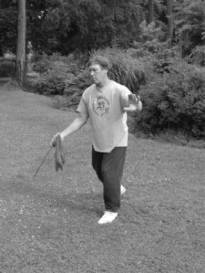 Continuing to step in for the uppercut.
Continuing to step in for the uppercut.
Shift the weight onto the left foot and continue to turn the torso until it faces west. Roll up onto the right toe.
The left hand continues to pull across the front of the body to the left. The saber starts to circle – first down to face the ground and then upward. This is a large swinging circle on the right side of the body.
Focus on the left hand to control the opponents saber hand, and also start to focus on the target.
Step ahead with the right foot, touching down the heel. The toe faces halfway between north and west. The torso faces slightly to the left of west.
The saber continues its circle upward. The left hand continues its pull to the left.
Focus on the left hand pulling, and the cutting edge of the saber as it nears the target.
Shift the weight onto the right foot until the knee just covers the toe. The torso faces slightly to the left. Look at the end of the saber.
The left hand ends to the left side of the body, palm facing outward to balance the forward momentum of the saber.
The saber is held with the sharp edge upward. It is angled about 45 degrees. The right hand is actually slightly to the right of the point, so the saber angles slightly inward. It is easier on the wrist with the elbow slightly more open then it would be if it were tucked close to the body. Dont stretch the saber out away from the body too much. This is a fairly close in maneuver.
Focus on the cutting edge.




